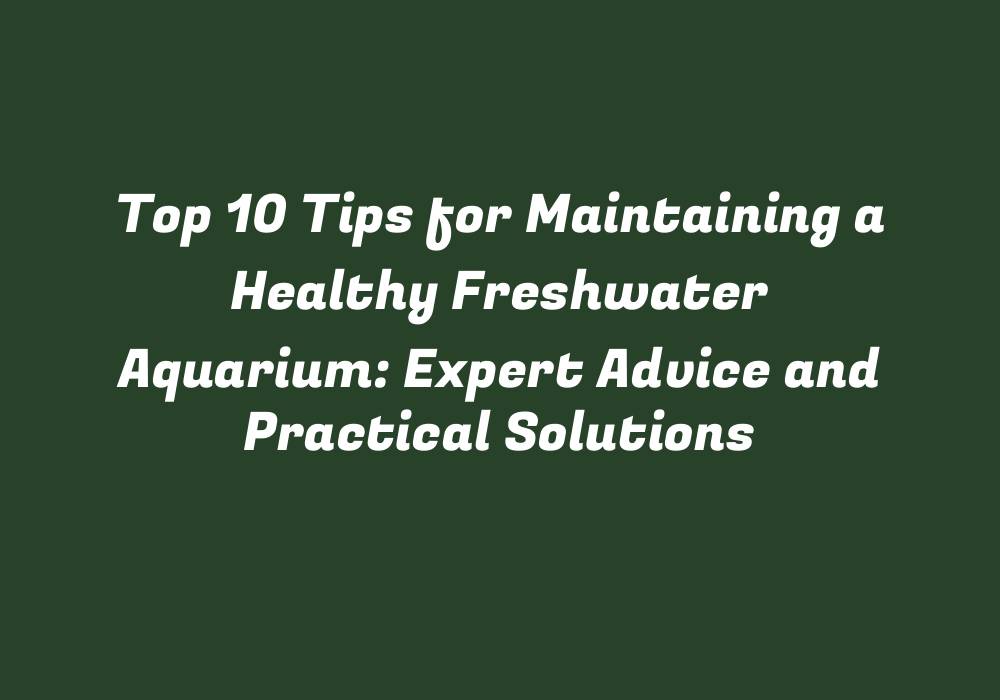Top 10 Tips for Maintaining a Healthy Freshwater Aquarium: Expert Advice and Practical Solutions
Maintaining a healthy freshwater aquarium is more than just placing fish and plants together. It requires patience, knowledge, and care to create the ideal environment where these creatures can thrive. In this article, we will provide 10 tips for successfully caring for your aquatic environment by following expert advice and practical solutions.
Tip 1: Choose the Right Aquarium
The first step towards building a healthy freshwater aquarium is to choose the right aquarium setup. Consider the size, shape, and type of tank that will suit your needs best. Larger tanks usually provide more stable water parameters for fish and plants, while smaller ones require more frequent maintenance. Choose between rectangular or cylindrical shapes depending on the available space in your home and the overall aesthetic you are aiming to achieve.
Tip 2: Select Appropriate Fish Species
It’s important to research the specific requirements of each fish species when adding them to an aquarium. Ensure that they can coexist harmoniously in terms of water temperature, pH levels, and tank size. Avoid overcrowding your tank, which leads to stress and potential health issues for your fish. Consider adding some shrimp or snails as cleaners to help maintain the cleanliness of your aquarium.
Tip 3: Proper Filtration System
A high-quality filtration system is crucial in maintaining a healthy freshwater aquarium. Select a filter that matches your tank size and has the ability to efficiently remove waste, excess food particles, and harmful chemicals from the water. Different types of filters are available – undergravel, hang-on-back (HOB), or canister filters. Consider the pros and cons of each type to determine which one suits your setup best.
Tip 4: Proper Water Parameters
To create a stable environment for your fish and plants, you need to maintain proper water parameters such as temperature, pH levels, and hardness. Use an aquarium thermometer to monitor the temperature of your tank regularly. Test your tap water and adjust pH levels with appropriate buffers if necessary. Regular water changes (about 10-25% of tank volume per week) will also help keep water parameters in check and maintain a healthy environment for your aquatic life.
Tip 5: The Importance of Aeration
Proper aeration is vital for the wellbeing of fish and plants, as it ensures they receive adequate oxygen. Aquarium air stones can help increase dissolved oxygen levels by creating bubbles that mix with the water. Consider using airstones or adjusting your filtration system to provide enough aeration. Avoid over-aerating the tank, which can cause gas bubble bloat in fish and lead to stress.
Tip 6: Provide Adequate Lighting
Plants need light for photosynthesis and growth. Ensure that your aquarium has appropriate lighting depending on the type of plants you choose (low, medium, or high-light requirements). Artificial lights can be placed above the tank to provide a suitable light spectrum for your plant species. Avoid direct sunlight to prevent algae overgrowth.
Tip 7: Regular Maintenance and Cleaning
A healthy freshwater aquarium requires frequent maintenance, including regular water changes, cleaning of glass walls and the substrate, vacuuming the gravel, and removing dead plants and debris. Keep your fish tank clean by scheduling regular cleaning tasks to maintain optimal water quality and ensure a stress-free environment for your aquatic life.
Tip 8: Feed Your Fish Appropriately
Proper nutrition is crucial for the health of your fish, but overfeeding can lead to water pollution, algae growth, and poor water quality. Offer small portions of food that your fish can consume within a few minutes, and feed them twice daily. Avoid feeding them live food to minimize stress and potential injuries from aggressive predators.
Tip 9: Monitor Water Quality and Test Frequently
Regularly testing the water parameters in your freshwater aquarium is essential for maintaining a healthy environment. Use an accurate testing kit, such as nitrate, ammonia, pH, and KH levels, to ensure that all values are within acceptable ranges. Make adjustments as necessary to keep your fish and plants thriving.
Tip 10: Enjoy the Beauty of Your Aquarium
Maintaining a freshwater aquarium requires time, dedication, and patience to create an environment where both plants and animals can flourish together. Relax and appreciate the beauty of your aquarium as you observe the daily interactions between the inhabitants of this underwater world.
In conclusion, creating and maintaining a healthy freshwater aquarium is an enriching experience that requires proper planning, research, and dedication. By following these 10 expert tips and practical solutions, you will ensure a stable environment for your fish, plants, and invertebrates to thrive, providing hours of enjoyment and satisfaction for yourself as well.
